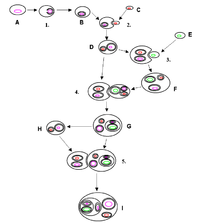
Plant jasmonic acid mediated contrasting effects of two citrus aphid species on Diaphorina citri Kuwayama.
Sign Up to like & getrecommendations! Published in 2022 at "Pest management science"
DOI: 10.1002/ps.7249
Abstract: BACKGROUND Herbivores may influence each other directly and through plant mediated inter-specific interactions. The Asian citrus psyllid (Diaphorina citri Kuwayama) and citrus aphids are key pests that can co-exist on citrus, but their plant- mediated… read more here.
Keywords: citrus aphid; aphid species; citri; plant ... See more keywords

Chemical footprints mediate habitat selection in co-occurring aphids
Sign Up to like & getrecommendations! Published in 2022 at "Behavioral Ecology"
DOI: 10.1093/beheco/arac076
Abstract: Abstract Habitat selection is a critical process that shapes the spatial distribution of species at local and regional scales. The mechanisms underlying habitat preference rely on environmental factors, species traits, and ecological interactions with other… read more here.
Keywords: habitat selection; chemical footprints; footprints mediate; aphid species ... See more keywords

Aphid Species and Feeding Location on Canola Influences the Impact of Glucosinolates on a Native Lady Beetle Predator
Sign Up to like & getrecommendations! Published in 2021 at "Environmental Entomology"
DOI: 10.1093/ee/nvab123
Abstract: Abstract Aphids that attack canola (Brassica napus L.) exhibit feeding preferences for different parts of canola plants, which may be associated with brassica-specific glucosinolates. However, this idea remains untested. Furthermore, canola aphid species employ different… read more here.
Keywords: canola; predator; feeding location; aphid species ... See more keywords

Feeding by Melanaphis sacchari (Hemiptera: Aphididae) Facilitates Use of Sorghum by Rhopalosiphum padi (Hemiptera: Aphididae), but Reciprocal Effects Are Negative
Sign Up to like & getrecommendations! Published in 2017 at "Environmental Entomology"
DOI: 10.1093/ee/nvw167
Abstract: Abstract In the process of feeding, aphids modify the physiology of their host plants in species-specific ways, and plant responses to these aggressions are often genotype- or cultivar-specific. Thus, different aphid species sharing a host… read more here.
Keywords: hemiptera aphididae; aphid; aphid species; sugarcane aphid ... See more keywords

Wolbachia Infection in Two Species: Novel Views on the Colonization Ability of Wolbachia in Aphids
Sign Up to like & getrecommendations! Published in 2019 at "Environmental Entomology"
DOI: 10.1093/ee/nvz122
Abstract: Abstract Wolbachia pipientis (Rickettsiales: Anaplasmataceae) is an intracellular symbiont residing in arthropods and filarial nematodes. Sixteen supergroups have been described from different host taxa. Four supergroups A, B, M, and N were found in aphids… read more here.
Keywords: infection two; infection; aphid species; wolbachia infection ... See more keywords

Survival and Feeding Rates of Four Aphid Species (Hemiptera: Aphididae) on Various Sucrose Concentrations in Diets.
Sign Up to like & getrecommendations! Published in 2017 at "Journal of economic entomology"
DOI: 10.1093/jee/tox168
Abstract: Different concentrations of sucrose were used to investigate how survival and feeding was affected in four species of aphids (Hemiptera: Aphididae). Seven sucrose concentrations were evaluated in feeding chambers fitted with parafilm membranes and infested… read more here.
Keywords: hemiptera aphididae; survival feeding; aphid species; sucrose concentrations ... See more keywords

Local adaptation to hosts and parasitoids shape Hamiltonella defensa genotypes across aphid species
Sign Up to like & getrecommendations! Published in 2022 at "Proceedings of the Royal Society B: Biological Sciences"
DOI: 10.1098/rspb.2022.1269
Abstract: Facultative symbionts are common in insects and are known to provide important adaptations that can drive rapid host evolution. Yet we still have a limited understanding of what shapes their distributions, such as why particular… read more here.
Keywords: hamiltonella strains; aphid species; hamiltonella defensa; host ... See more keywords

Differences in egg hatching time between cyclical and obligate parthenogenetic lineages of aphids
Sign Up to like & getrecommendations! Published in 2019 at "Insect Science"
DOI: 10.1111/1744-7917.12493
Abstract: Many aphid species exhibit a variation in reproductive mode which is influenced by winter climate regimes, with cyclical parthenogenetic (CP) lines dominating in cold winter areas (because they produce cold‐resistant eggs) and obligate parthenogenetic (OP)… read more here.
Keywords: winter; hatching time; egg hatching; differences egg ... See more keywords

Transcriptional changes in the aphid species Myzus cerasi under different host and environmental conditions
Sign Up to like & getrecommendations! Published in 2019 at "Insect Molecular Biology"
DOI: 10.1111/imb.12631
Abstract: Aphids feature complex life cycles, which in the case of many agriculturally important species involve primary and secondary host plant species. Whilst host alternation between primary and secondary host can occur in the field depending… read more here.
Keywords: secondary host; aphid species; changes aphid; host ... See more keywords

Epiphytic Strains of Pseudomonas syringae Kill Diverse Aphid Species
Sign Up to like & getrecommendations! Published in 2021 at "Applied and Environmental Microbiology"
DOI: 10.1128/aem.00017-21
Abstract: Sap-sucking aphids are insects of huge agricultural concern, not only because of direct damage caused by feeding but also because of their ability to transmit various plant pathogens. Some bacteria that grow on leaf surfaces,… read more here.
Keywords: diverse aphid; kill; aphid species; insects ... See more keywords

Tuberocephalus tsengi (Tao, 1963) STAT. REV. (Hemiptera: Aphididae), an East Asian Artemisia-feeding aphid species introduced to Britain.
Sign Up to like & getrecommendations! Published in 2020 at "Zootaxa"
DOI: 10.11646/zootaxa.4743.1.14
Abstract: Tuberocephalus tsengi (Tao, 1963) STAT. REV., an aphid species described from China, is reported feeding on Artemisia vulgaris in southern England. This species is here redescribed and distinguished from T. sasakii (Matsumura, 1917), with which… read more here.
Keywords: tsengi tao; tao 1963; aphid species; stat rev ... See more keywords